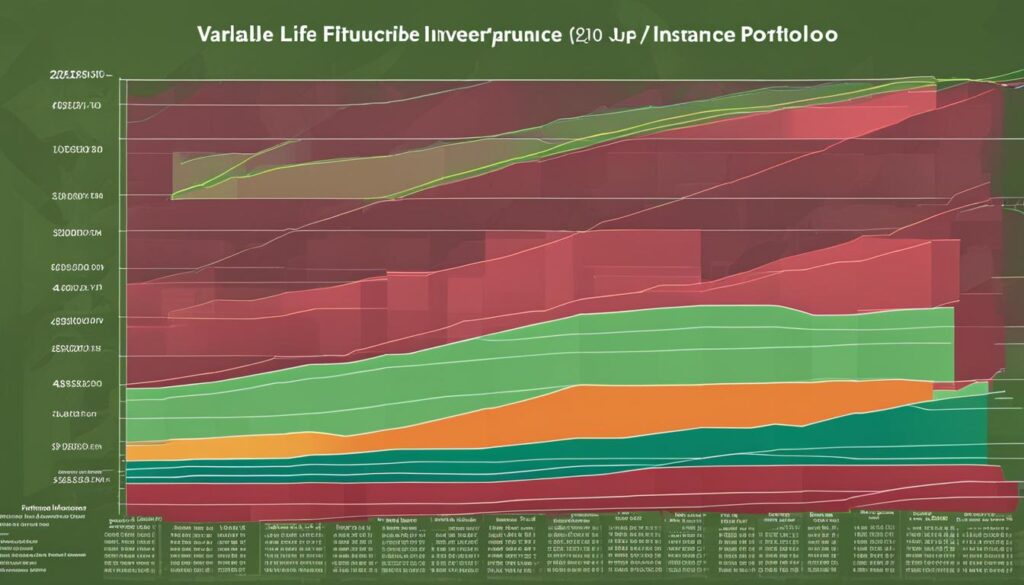Read:16 mins
Variable life insurance, also known as investment-linked life insurance, is a type of permanent life insurance policy that provides lifelong insurance protection along with flexible premiums and a cash value component. This unique insurance product allows policyholders to invest the cash value in subaccounts that function like mutual funds, offering the potential for high returns. However, it’s important to note that variable life insurance also exposes policyholders to market fluctuations and potential losses.
Key Takeaways:
- Variable life insurance combines lifelong insurance protection with flexible premiums and a cash value component.
- Policyholders can invest the cash value in subaccounts, similar to mutual funds, which provide potential for high returns.
- However, variable life insurance also exposes policyholders to market fluctuations and potential losses.
- It offers increased flexibility and growth potential compared to other life insurance options.
- It’s important to carefully assess the risks involved before purchasing variable life insurance.
What is Variable Life Insurance?
Variable life insurance is a type of permanent life insurance policy that provides both insurance protection and an investment component. With variable life insurance, you have the opportunity to build cash value by investing in various subaccounts, such as stocks, bonds, and money market funds. The performance of these investments determines the growth of your cash value. This gives you the potential for high returns, but it also exposes you to market fluctuations and potential losses.
Unlike other types of life insurance policies, variable life insurance allows you to have more control over your investment options. You can choose the subaccounts you want to invest in, based on your risk tolerance and investment objectives. This flexibility is one of the key advantages of variable life insurance, as it offers the potential for growth that can outpace traditional life insurance policies.
It’s important to note that variable life insurance is an insurance policy with an investment component, and it carries certain risks. The value of your cash value and the returns on your investments can fluctuate based on market conditions. Additionally, variable life insurance policies may have higher fees and expenses compared to other types of insurance policies. Therefore, it’s essential to carefully consider your financial goals and risk tolerance before purchasing a variable life insurance policy.
| Key Features of Variable Life Insurance | Benefits | Risks |
|---|---|---|
| Combines insurance protection and investment component | Potential for high investment returns | Exposure to market fluctuations and potential losses |
| Allows investment in various subaccounts | Flexibility in investment options | Investment performance depends on market conditions |
| Policyholder controls investment choices | Potential for cash value growth | Higher fees and expenses |
How Does Variable Life Insurance Work?
Variable life insurance works by combining a death benefit with a cash value component. When you purchase a variable life insurance policy, you pay premiums. A portion of these premiums goes towards the cost of insurance, ensuring that your beneficiaries receive a death benefit if you pass away. The remaining portion of the premiums is allocated to the cash value of the policy.
The cash value of your variable life insurance policy can be invested in various subaccounts, such as stocks, bonds, and money market funds. The growth of the cash value depends on the performance of these investments. You have the flexibility to choose how your cash value is allocated among the different subaccounts, giving you control over your investment strategy.
However, it’s important to note that with this flexibility comes investment risk. The value of your cash value can fluctuate based on the performance of the underlying investments. If the investments perform well, your cash value can grow significantly. On the other hand, poor investment performance can lead to a decrease in the cash value of your policy. It’s crucial to carefully assess your risk tolerance and investment objectives before purchasing a variable life insurance policy.
Example Table: Comparison of Cash Value Growth
| Year | Variable Life Insurance | Traditional Life Insurance |
|---|---|---|
| 1 | £10,000 | £5,000 |
| 5 | £25,000 | £10,000 |
| 10 | £50,000 | £15,000 |
This table provides a hypothetical example that demonstrates the potential growth of cash value in a variable life insurance policy compared to a traditional life insurance policy over a 10-year period. It highlights the higher growth potential of variable life insurance due to the investment component.
It’s important to consult with a financial advisor or insurance professional to understand the specific terms and conditions of any variable life insurance policy you are considering. They can help you evaluate the potential risks and rewards and guide you in making an informed decision.
Pros and Cons of Variable Life Insurance
When considering variable life insurance, it’s important to weigh the pros and cons to make an informed decision. Here are some advantages and disadvantages to keep in mind:
Pros:
- Control over cash value investments: With variable life insurance, you have the flexibility to choose how the cash value is invested. This allows you to align your investments with your risk tolerance and financial goals.
- High growth potential: Unlike traditional life insurance policies, variable life insurance offers the potential for high investment returns. By investing in subaccounts such as stocks and bonds, you can take advantage of market growth.
- Flexible premium payments: Variable life insurance policies often allow policyholders to adjust their premium payments over time. This can be beneficial if your financial situation changes or if you want to increase or decrease your coverage.
Cons:
- Risk of cash value losses: Investing the cash value in subaccounts exposes you to market fluctuations and potential losses. If the investments perform poorly, your cash value may decrease, impacting the growth potential of your policy.
- Possible increase in premiums: If the investments within your policy underperform, the insurance company may require you to pay higher premiums to maintain the desired death benefit. This can make variable life insurance more expensive over time.
- High fees and charges: Variable life insurance policies often come with higher fees and charges compared to other types of life insurance. These fees can eat into the cash value and affect the overall returns of the policy.
It’s important to carefully consider these pros and cons when evaluating variable life insurance. While the potential for high returns and flexibility may be appealing, the risks and costs associated with this type of policy should also be taken into account. Variable life insurance is not suitable for everyone, and it’s crucial to assess your individual needs and priorities before making a decision.

Suitability and Alternatives to Variable Life Insurance
When considering variable life insurance, it’s important to assess its suitability for your individual needs. While variable life insurance offers flexibility and the potential for high returns, it may not be the right choice for everyone. Here are some factors to consider:
Investment Risk:
Variable life insurance involves investing the cash value in subaccounts that can fluctuate with the market. If you have a higher risk tolerance and prefer managing your own investments, variable life insurance may be suitable. However, if you are risk-averse and prefer a more stable investment option, alternatives should be considered.
Insurance and Investment Objectives:
Before purchasing variable life insurance, evaluate your insurance and investment objectives. If you’re looking for permanent life insurance protection with the potential for tax-deferred growth, variable life insurance may be worth considering. However, if your main objective is solely life insurance coverage, without the need for investment flexibility, other insurance options may be more suitable.
Alternatives:
There are alternatives to variable life insurance that may better align with your needs. Consider the following:
- Universal Life Insurance: Offers more flexibility in premium payments and death benefits compared to variable life insurance.
- Whole Life Insurance: Provides lifetime coverage and a guaranteed cash value component.
- Term Life Insurance: Offers affordable coverage for a specific term without a cash value component.
Each alternative has its own benefits and drawbacks. It’s important to carefully evaluate your insurance and investment needs before making a decision.

What is VUL in Insurance?
VUL, which stands for Variable Universal Life, is a type of permanent life insurance policy that offers both insurance coverage and an investment component. With VUL, policyholders have the opportunity to invest a portion of their policy’s cash value in the market, aiming for potential investment returns. However, it’s important to note that VUL policies come with investment risks and may not match the performance of direct market investments.

Variable Universal Life insurance offers the advantage of potential higher investment returns compared to traditional life insurance policies. Policyholders have the flexibility to select from various investment options, such as mutual funds and stocks, based on their risk tolerance and investment objectives. This allows for customization and the potential for growth in the policy’s cash value over time. However, it’s crucial to understand the features and risks associated with VUL before considering it as an investment option.
“VUL insurance may boost returns during bull markets, but it may not match the performance of direct market investments.”
Benefits of Variable Universal Life Insurance
Variable Universal Life insurance offers several benefits. Policyholders have the ability to take loans or withdrawals against the cash value of the policy, providing financial flexibility in times of need. The cash value growth within VUL policies also has the potential to outperform other types of life insurance policies, allowing for potential tax-deferred growth. Additionally, policyholders have the flexibility to choose from a range of investment options, tailoring the policy to their individual investment preferences and goals.
Risks of Variable Universal Life Insurance
Alongside the benefits, there are risks and downsides to consider with Variable Universal Life insurance. As VUL policies are tied to market performance, poor investment performance can lead to losses in the policy’s cash value. Additionally, the impact of fees on cash value growth should be carefully evaluated, as high fees can reduce the overall returns. It’s also worth noting that maintaining the policy may require additional premium payments, making it essential to carefully assess the long-term financial commitment.
How Does Variable Universal Life Insurance Work?
Variable universal life insurance (VUL) is a flexible type of permanent life insurance policy that combines a death benefit with a cash value component. With VUL, you have the opportunity to invest the cash value in various options, such as mutual funds and stocks. The growth of the cash value is based on the performance of these investments. You have the flexibility to adjust your premium payments and the death benefit within certain limits, allowing you to customize the policy to suit your needs.
One of the key features of VUL is the cash value, which serves as a savings component that can accumulate over time. You can access this cash value through policy loans or withdrawals, providing you with a source of funds for various financial needs. Additionally, the cash value in a VUL policy has the potential for tax-deferred growth, meaning you won’t have to pay taxes on any investment gains until you withdraw the funds.
However, it’s important to note that VUL also comes with risks. The performance of your investments can vary, and if they underperform, it may impact the cash value and potentially the death benefit of your policy. Additionally, VUL policies typically come with fees and charges that can reduce the overall growth of the cash value. It’s essential to carefully consider the benefits and risks before purchasing a VUL policy and to ensure it aligns with your long-term financial goals.
| Benefits of Variable Universal Life Insurance (VUL) | Risks of Variable Universal Life Insurance (VUL) |
|---|---|
|
|
In conclusion, variable universal life insurance provides you with the opportunity to combine life insurance protection with investment potential. It offers flexibility in premium payments, death benefit, and investment options. However, it also comes with investment risks and fees that need to be carefully considered. If you’re interested in a VUL policy, it’s important to assess your financial situation, risk tolerance, and long-term goals to determine if it’s the right fit for you.
Benefits and Risks of Variable Universal Life Insurance
Variable Universal Life Insurance (VUL) offers a range of benefits that make it an attractive option for those seeking both life insurance coverage and investment opportunities. One of the key benefits is the ability to take loans or withdrawals against the cash value of the policy. This can provide policyholders with much-needed liquidity in times of financial need. Additionally, VUL offers the potential for tax-deferred growth, allowing policyholders to potentially accumulate more funds over time compared to other types of life insurance policies. The flexibility in investment choices is another advantage, as it allows policyholders to customize their investment portfolio according to their risk tolerance and investment objectives.
However, it is important to carefully consider the risks associated with VUL before deciding to purchase a policy. One of the main risks is the potential for losses due to poor investment performance. Unlike traditional life insurance policies, VUL policyholders bear the investment risk themselves. If the underlying investments perform poorly, the cash value of the policy may decrease, which can impact the death benefit and the overall value of the policy. Additionally, VUL policies often come with high fees and charges, which can eat into the cash value and potentially reduce the overall return on investment. It is important to carefully review and understand the fee structure of the policy before making a decision.
In summary, Variable Universal Life Insurance offers several benefits, such as the ability to access cash value, potential tax advantages, and investment flexibility. However, it also comes with risks, including the potential for investment losses and high fees. Evaluating the benefits and risks is crucial in determining whether VUL is the right life insurance option for your financial goals and risk tolerance. Make sure to carefully read the policy documents and consult with a financial advisor to make an informed decision.

[Table]
| Benefits of VUL | Risks of VUL |
|—————————-|—————————————–|
| Access to cash value | Potential for investment losses |
| Potential tax advantages | High fees and charges |
| Investment flexibility | Dependence on investment performance |
| | |
| | |
[/Table]
Conclusion
In summary, variable life insurance in the UK provides a detailed overview of a permanent life insurance policy that offers flexibility in premium payments and investment options. With a combination of a death benefit and a cash value component, policyholders have the opportunity to invest in various subaccounts and potentially achieve high returns. However, it is important to consider the investment risks and carefully assess the associated fees and charges.
When considering variable life insurance in the UK, it is crucial to evaluate individual suitability. This type of insurance may be suitable for those who are comfortable with investment risks and prefer managing their own investments. It is important to explore alternatives such as universal life insurance, whole life insurance, and term life insurance to ensure the chosen policy aligns with specific insurance and investment needs.
Overall, variable life insurance in the UK offers a detailed overview of a permanent life insurance policy with flexible options. By understanding the benefits and risks associated with this type of insurance, individuals can make informed decisions that align with their financial goals and objectives.
FAQ
What is variable life insurance?
Variable life insurance is a type of permanent life insurance policy that combines lifelong insurance protection with flexible premiums and a cash value component. It allows policyholders to invest the cash value in subaccounts that operate like mutual funds, providing potential for high returns but also exposing them to market fluctuations and potential losses.
How does variable life insurance work?
Variable life insurance works by combining a death benefit with a cash value component. The policyholder pays premiums, a portion of which goes towards the cost of insurance and the rest goes towards the cash value. The cash value can be invested in various subaccounts, and its growth depends on the performance of these investments. The policyholder has the flexibility to adjust premium payments and the death benefit within certain limits.
What are the pros and cons of variable life insurance?
Pros of variable life insurance include control over cash value investments, high growth potential, and flexible premium payments. Policyholders have the ability to choose investments that align with their risk tolerance and investment objectives. However, there are also cons to consider, such as the risk of cash value losses, possible increase in premiums, and high fees and charges. Variable life insurance is not suitable for everyone, and careful consideration of the pros and cons is necessary before deciding to purchase a policy.
Is variable life insurance suitable for everyone?
Variable life insurance may be suitable for individuals who want permanent life insurance protection, have a higher risk tolerance for investing, and prefer managing their own investments. It may be worth considering for those who have maxed out other retirement accounts and want additional tax-deferred investment growth. However, there are alternatives to consider, such as variable life insurance, universal life insurance, whole life insurance, and term life insurance. Each alternative has its own benefits and drawbacks, and individuals should carefully evaluate their insurance and investment needs before making a decision.
What is VUL in insurance?
VUL stands for Variable Universal Life. It is a type of permanent life insurance policy that allows policyholders to invest a portion of the cash value in the market and earn a return. VUL policies offer the potential for higher investment returns compared to traditional life insurance policies but also come with investment risk. Understanding the features and risks of VUL is important before considering it as an investment option.
How does variable universal life insurance work?
Variable universal life insurance is a type of permanent life insurance policy that combines a death benefit with a cash value component. Policyholders pay premiums, which are divided into the cost of insurance, fees, and the cash value. The cash value can be invested in various investment options, such as mutual funds and stocks. The growth of the cash value is based on the performance of these investments. The policyholder has the flexibility to adjust premium payments and the death benefit within certain limits.
What are the benefits and risks of variable universal life insurance?
Benefits of variable universal life insurance include the ability to take loans or withdrawals against the cash value, potential tax-deferred growth, and flexibility in investment choices. Cash value growth has the potential to outperform other types of life insurance policies. However, there are risks and downsides to consider, such as the potential for losses due to poor investment performance, the impact of fees on cash value growth, and the need for additional premium payments to maintain the policy. Evaluating the benefits and risks is crucial before purchasing a variable universal life insurance policy.